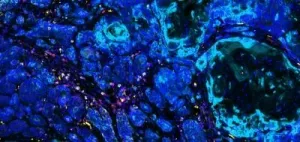(Press-News.org) Highlights
In a study of patients waiting for a kidney transplant, those who experienced various symptoms had a higher risk of dying while on the waitlist.
Symptoms tended to increase or remain unchanged between transplant evaluation and transplantation; however, at 3 months after transplantation, 9 of 11 symptoms lessened.
Washington, DC (June 18, 2021) -- Investigators have examined how various symptoms experienced by individuals with kidney failure are impacted by kidney transplantation. The findings will appear in an upcoming issue of CJASN.
People with kidney failure must often deal with numerous symptoms, such as fatigue, cramping, muscle soreness, numbness, dizziness, and loss of appetite. Although kidney transplantation is the optimal treatment for restoring kidney function in patients with kidney failure, how it affects these symptoms is unclear.
To investigate, Mara A. McAdams-DeMarco, PhD (Johns Hopkins) and her colleagues analyzed information on 1,298 kidney transplant candidates and 521 kidney transplant recipients. "This is the first study to investigate how symptoms change before and after kidney transplantation," said Dr. McAdams-DeMarco.
Candidates reported being moderately to extremely bothered by fatigue (32%), dry skin (27%), muscle soreness (26%), and itchy skin (25%); 16% reported high and 21% reported very high symptom burden. During a median follow-up of 1.9 years, 12% of patients died on the waitlist, and those with very high symptom burden had a 67% higher risk. By the time patients were to receive transplants, 34% experienced an increased symptom burden while 42% remained unchanged.
Among kidney transplant recipients, patients experienced a lessening of symptoms following transplantation, with an overall 10% improvement in symptoms, followed by little further change from 3 months through 12 months after surgery. There were early (first 3 months) improvements in 9 of 11 symptoms, and itchy skin and fatigue had the greatest improvements.
"Our findings on the post-transplantation change in symptoms can help inform the important discussion surrounding post-transplant care, clarify the timeline for improvement, identify populations who are most likely to benefit, and promote patient-centered care," said Dr. McAdams-DeMarco.
An accompanying Patient Voice describes the perspective and experience of David Rodriguez, who was diagnosed with kidney failure in 2008 at the age of 36 and then received a kidney transplant through a paired-exchange kidney donation.
INFORMATION:
Study co-authors include Kathryn Taylor, RN, MPH, Nadia M. Chu, PhD, MPH, Xiaomeng Chen, MSPH, Zhan Shi, MHS, Eileen Rosello, BA, Sneha Kunwar, BA, Paul Butz, BS, Silas Norman, MD, Deidra C. Crew, MD, ScM, Keiko I. Greenberg, MD, MHS, Aarti Mathur, MD, Dorry L. Segev, MD, PhD, and Tariq Shafi, MBBS, MHS.
Disclosures: Funding for this study was provided by the National Institute of Diabetes and Digestive and Kidney Disease and the National Institute on Aging: grant numbers K01AG064040 (PI: Chu), R01AG055781 (PI: McAdams-DeMarco), R01DK114074 (PI: McAdams-DeMarco), K23AG053429 (PI: Mathur), and K24AI144954 (PI: Segev). Kathryn Taylor was supported by the National Center for Advancing Translational Sciences grant TL1TR003100. Tariq Shafi was supported by National Institute of Nursing Research (R01NR017399) and National Heart, Lung, and Blood Institute (NHLBI) (R01HL132372). Deidra Crews was supported by NHLBI (K24HL148181). Keiko Greenberg was supported by NHLBI (R01HL132372) and NIA (UH3AG056933). Funders had no role in the study design, data collection, analysis, reporting, or decision to submit for publication.
The article, titled "Kidney Disease Symptoms Before and After Kidney Transplantation," will appear online at http://cjasn.asnjournals.org/ on June 18, 2021, doi: 10.2215/CJN.19031220.
The accompanying Patient Voice will be posted online when available.
The content of this article does not reflect the views or opinions of The American Society of Nephrology (ASN). Responsibility for the information and views expressed therein lies entirely with the author(s). ASN does not offer medical advice. All content in ASN publications is for informational purposes only, and is not intended to cover all possible uses, directions, precautions, drug interactions, or adverse effects. This content should not be used during a medical emergency or for the diagnosis or treatment of any medical condition. Please consult your doctor or other qualified health care provider if you have any questions about a medical condition, or before taking any drug, changing your diet or commencing or discontinuing any course of treatment. Do not ignore or delay obtaining professional medical advice because of information accessed through ASN. Call 911 or your doctor for all medical emergencies.
Since 1966, ASN has been leading the fight to prevent, treat, and cure kidney diseases throughout the world by educating health professionals and scientists, advancing research and innovation, communicating new knowledge, and advocating for the highest quality care for patients. ASN has more than 21,000 members representing 131 countries. For more information, visit http://www.asn-online.org.
New findings published this week in Physical Review Letters suggest that carbon, oxygen, and hydrogen cosmic rays travel through the galaxy toward Earth in a similar way, but, surprisingly, that iron arrives at Earth differently. Learning more about how cosmic rays move through the galaxy helps address a fundamental, lingering question in astrophysics: How is matter generated and distributed across the universe?
"So what does this finding mean?" asks John Krizmanic, a senior scientist with UMBC's Center for Space Science and Technology (CSST). "These are indicators of something interesting happening. And what that ...
Just as the skeleton and muscles move the human body and hold its shape, all the cells of the body are stabilised and moved by a cellular skeleton. Unlike our skeleton, this cellular skeleton is a very dynamic structure, constantly changing and renewing itself. It consists of different types of protein filaments, which include intermediate filaments and microtubules. Now, a research team from the University of Göttingen is the first to succeed in observing a direct interaction between microtubules and intermediate filaments outside the cell, and also in quantitatively measuring this interaction. The results of the study were published in Nature Communications.
Microtubules are dynamic filaments ...
Study Highlights
New research reveals how key proteins interact to regulate the body's response to stress
Targeting these proteins may help treat or prevent stress-related psychiatric disorders
The biological mechanisms behind stress-related psychiatric conditions, including major depressive disorder and post-traumatic stress disorder (PTSD), are poorly understood.
New research now details the interplay between proteins involved in controlling the body's stress response and points to potential therapeutic targets when this response goes awry. The study, which was conducted by an international team led by investigators at McLean Hospital, appears in ...
BOSTON - Researchers from Massachusetts General Hospital (MGH) have discovered a biological mechanism that transforms cells exposed to carcinogens from environmental factors like smoking and ultraviolet light into immunogenic cells that can be harnessed therapeutically to fight treatment-resistant cancers. As reported in Science Advances, that mechanism involves spurring the release of small proteins known as chemokines which, in turn, recruit antitumor immune cells (CD8+ T cells) to the tumor site to block metastasis, potentially enhancing the effectiveness of a new generation of immunotherapies.
"Immunotherapeutics ...
CHICAGO --- Scientists have long known the brain's hippocampus is crucial for long-term memory. Now a new Northwestern Medicine study has found the hippocampus also plays a role in short-term memory and helps guide decision-making.
The findings shed light on how the hippocampus contributes to memory and exploration, potentially leading to therapies that restore hippocampal function, which is impacted in memory-related aging and neurodegenerative diseases such as dementia, the study authors said.
In the study, scientists monitored participants' brain activity and tracked their eye movements while looking at different complex pictures. The scientists discovered ...
Birds build nests to keep eggs and baby nestlings warm during cool weather, but also make adjustments in nest insulation in such a way the little ones can keep cool in very hot conditions. Mammals, such as rabbits or groundhogs, sleep or hibernate in underground burrows that provide stable, moderate temperatures and avoid above-ground conditions that often are far more extreme outside the burrow.
Michael Dillon, an associate professor in the University of Wyoming Department of Zoology and Physiology, was part of a research group that examined animals' ability to respond to climate change likely depends on how well they modify their habitats, ...
BIRMINGHAM, Ala. - A comprehensive health-screening program in rural northern KwaZulu-Natal, South Africa, has found a high burden of undiagnosed or poorly controlled non-communicable diseases, according to a study published in The Lancet Global Health.
Researchers found that four out of five women over the age of 30 were living with a chronic health condition, and that the HIV-negative population and older people -- especially those over 50 -- bore the higher burden of undiagnosed or poorly controlled non-communicable diseases such as diabetes and hypertension.
The study was co-led by Emily Wong, M.D., a resident faculty member at the Africa Health ...
Irvine, CA - June 18, 2021 - A new study paves the way for the development of next generation therapeutics for the prevention and treatment of Clostridioides difficile infection (CDI), the most frequent cause of healthcare-acquired gastrointestinal infections and death in developed countries.
Published today in Nature Communications, the study reveals the first 3D structure of the Clostridioides difficile toxin B (TcdB) in complex with chondroitin sulfate proteoglycan 4 (CSPG4), a human receptor. The study was co-led by senior author Rongsheng Jin, PhD, a professor in the Department of Physiology & Biophysics at the University of California, Irvine, School of Medicine, and Min Dong, PhD, an associate professor at Harvard Medical School.
"TcdB is one of two homologous C. ...
June 18, 2021 - An experimental artificial heart includes an autoregulation control mechanism, or Auto-Mode, that can adjust to the changing needs of patients treated for end-stage heart failure. Outcomes in the first series of patients managed with the new heart replacement pump in Auto-Mode are presented in the ASAIO Journal, official journal of the American Society for Artificial Internal Organs. The journal is published in the Lippincott portfolio by Wolters Kluwer.
The study reports on the response to "pressure sensor-based autoregulation of blood flow" in ten patients for up to two years after implantation of the Carmat Total Artificial ...
The visual thalamus is classically known to relay visual stimuli coming from the retina to the cerebral cortex. Researchers from the Max Planck Institute of Neurobiology now show that although neurons in the mouse visual thalamus connect to both eyes, they establish strong functional connections only with one retina. These results settle partly contradictory results of earlier studies and demonstrate how important it can be to complement structural data with functional analyses.
We have two eyes, but perceive the tree in front of us only once. Our brain therefore has the complicated task of combining the information of both eyes in a meaningful way. To do so, visual stimuli first travel from the retina via so-called ganglion cells to the visual thalamus. There, the information does end up ...





